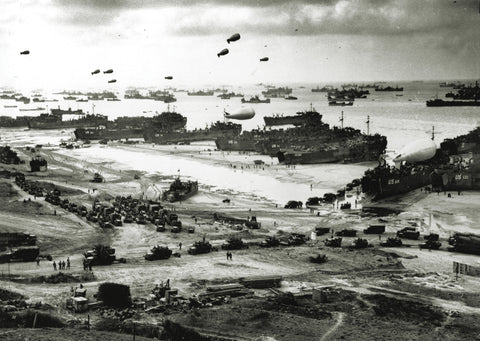
We Remember the Fighting. But What About the Shipping?
It’s probably fair to say that most of us spend a lot more time thinking about the folks leaping from landing craft than we do about the landing craft themselves, yet back in August this year, at the extraordinary D-Day Ohio event at Conneaut, Ohio, on the shores of Lake Erie, I finally got to ride in a Higgins boat. Perched next to the coxswain, I looked down and watched the wires moving back and forth as they pulled the rudder this way and that and was struck by how incredibly rudimentary it all was. Such a simple design and really with just one purpose: to deliver a small vehicle or assault platoon directly onto a beach. It was 36 feet long, 11 wide, and could do about 12 knots on a calm sea.
Incredibly, the Allies had no landing craft at all when the war broke out in September 1939, and although Andrew Higgins in New Orleans delivered a “landing craft, personnel (large)”—LCP—to the British at the back end of 1940, it wasn’t until May 1941 that the first Higgins boat received its trials. By this time, it was clear that Britain would have to launch any future assault on Europe from the sea, and that if the United States entered the war it would be in the same position. As things turned out, landing craft became one of the most vital items in the Allied arsenal, essential for operations in the Pacific as well as in the Mediterranean and, of course, Normandy.
Nor were the Higgins boats the only landing craft. Rather, a huge array was developed and produced, not least the incredible LST—landing ship, tank—which was 382 feet long, had a draft under the ship’s forward bow of just four feet, and could deliver 18 Sherman tanks or more than 200 troops directly onto a beach. This meant the Allies no longer needed a port and quaysides for an amphibious attack; as both the November 1942 Torch landings in Northwest Africa and then the July 1943 assault on Sicily showed, the LSTs and slightly smaller LCTs (landing craft, tank) were game changers for the Allies. Much of the Sicilian campaign, for example, was supplied by these landing craft, even as some ports became available.
The U.S. Navy had, in fact, woken up a little late to the urgent need to build huge numbers of landing craft, but between April 1942 and May 1943 shipyards across the States produced a staggering 8,719 of all types, including the truly revolutionary DUKW—pronounced “duck”—a remarkable wheeled, amphibious craft that could drive straight off the beaches.
These were still not enough, however, as the U.S. accelerated its efforts in the Pacific and put Overlord, the invasion of Normandy, as its priority for the war against Germany. It meant that after Sicily, when General Mark Clark’s Fifth Army landed at Salerno, south of Naples, on September 9, 1943, he had nothing like enough assault craft. For Sicily, the Allies had 1,743, but for Avalanche, the codename for the Salerno landings, just 359. Clark could land only a meager three divisions and a handful of special forces in the initial attack. So, despite vast forces in the Mediterranean, the Allies’ assault was far smaller than ideal. Avalanche was an incredibly high-risk enterprise as a result, albeit one that fortunately prevailed.
Nor were there enough landing craft for D-Day. Although 4,127 were involved, General Bernard Law Montgomery, the land force commander, wanted more; a sixth beach, Band, had to be abandoned because of the shortage. Outflanking operations in Italy and Burma were discarded for lack of assault craft, while the landings at Anzio in Italy, in January 1944, also lacked sufficient strength for want of these vital vessels.
As the Higgins craft rumbled across the water on Lake Erie, I was struck by how incredibly simple this box-like craft was, but also how valuable. Assault craft were key to the entire western Allies’ way of war and yet had there been even more of them, what a difference that would have made. Perhaps the war really would have been over earlier.
